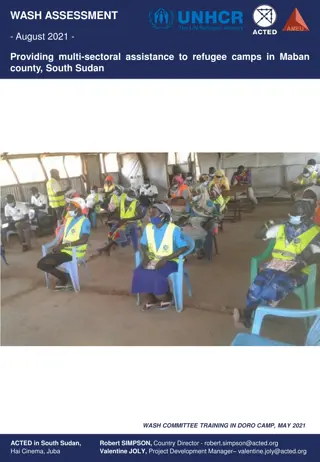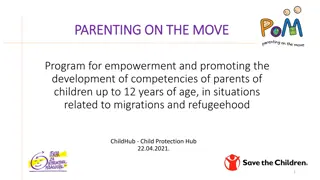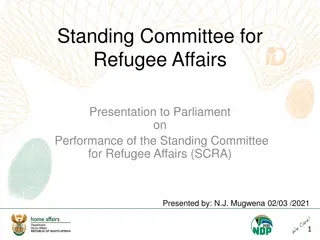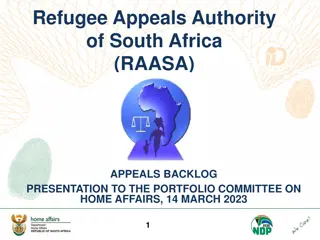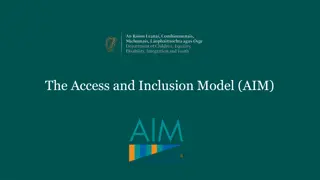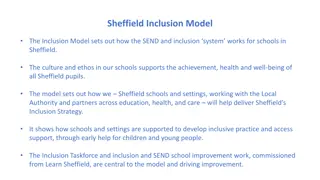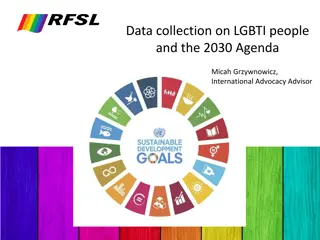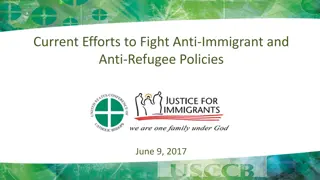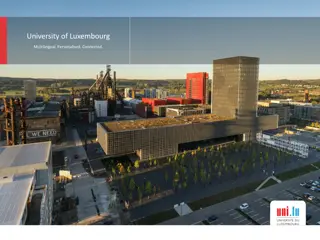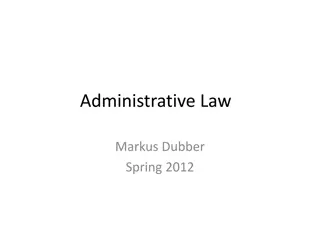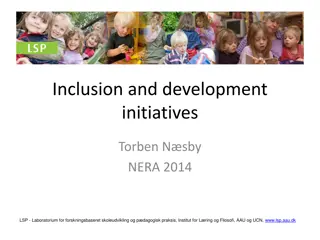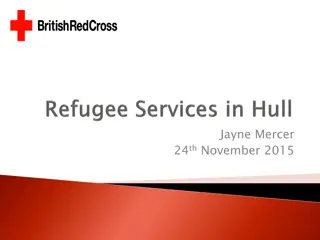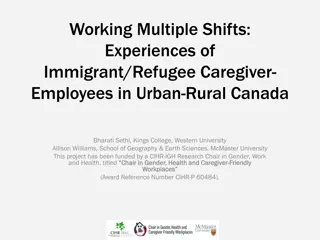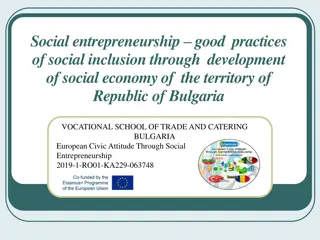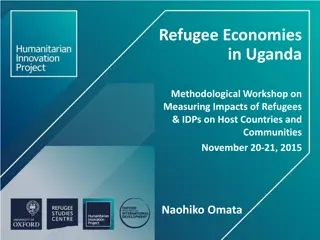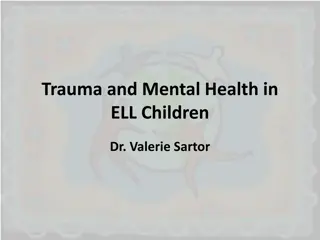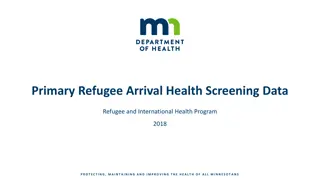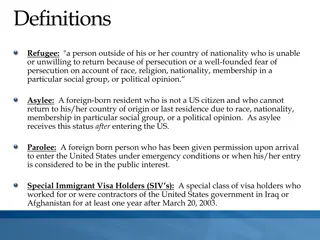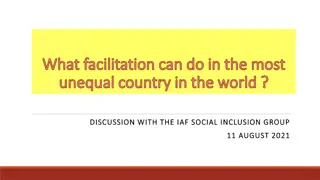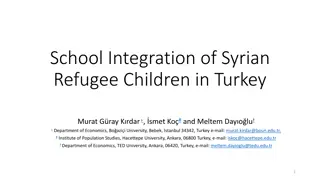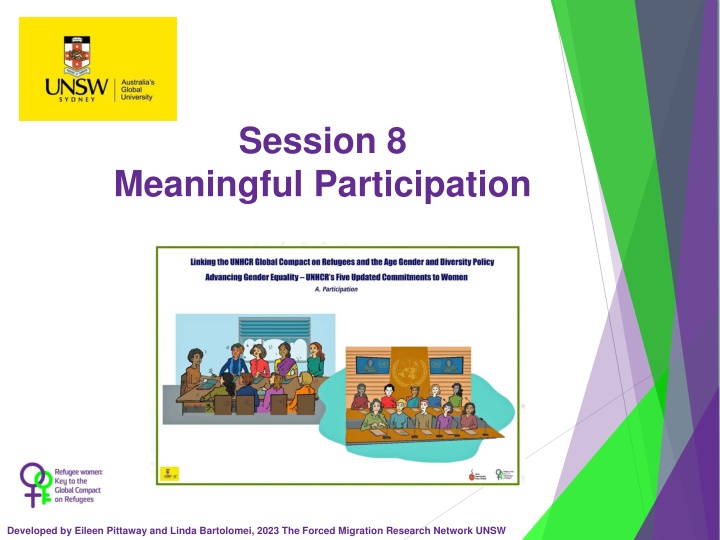
Refugee Participation and Social Inclusion
Refugee participation involves being prepared for and engaging in decision-making processes ethically and financially supported, while social inclusion emphasizes active and meaningful involvement in all aspects of the host society. Barriers must be addressed to ensure genuine and inclusive participation.
Download Presentation

Please find below an Image/Link to download the presentation.
The content on the website is provided AS IS for your information and personal use only. It may not be sold, licensed, or shared on other websites without obtaining consent from the author. If you encounter any issues during the download, it is possible that the publisher has removed the file from their server.
You are allowed to download the files provided on this website for personal or commercial use, subject to the condition that they are used lawfully. All files are the property of their respective owners.
The content on the website is provided AS IS for your information and personal use only. It may not be sold, licensed, or shared on other websites without obtaining consent from the author.
E N D
Presentation Transcript
Session 8 Meaningful Participation Developed by Eileen Pittaway and Linda Bartolomei, 2023 The Forced Migration Research Network UNSW
What is refugee participation? When refugees regardless of location, legal recognition, gender, identity and demographics are prepared for and participating in fora and processes where strategies are being developed and/or decisions are being made (including at local, national, regional, and global levels, and especially when they facilitate interactions with host states, donors, or other influential bodies), in a manner that is ethical, sustained, safe, and supported financially. The Global Refugee Network https://www.asylumaccess.org/wp-content/uploads/2019/12/Meaningful- Refugee-Participation-Guidelines_Web.pdf (page 7) Intellectual property of E Pittaway and L. Bartolomei; Reuse is permitted with author attribution
Social Inclusion Social inclusion refers to the active and meaningful participation of refugees in the social, economic, cultural, and political aspects of the host society. It takes a human rights approach, treating refugees with respect, fostering a sense of belonging and empowering them to contribute positively to society at a local, national and international level, through their inclusion and advocacy (Kenny and Connors 2017: 30) Intellectual property of E Pittaway and L. Bartolomei; Reuse is permitted with author attribution
Spaces where people might want to participate in decision making and activities. Family Local community Ethnic group Refugee groups and organisations In decision making with NGOs, UNHCR and other key agencies In Government agencies In Health services Education In employment Other important places we might have missed. Intellectual property of E Pittaway and L. Bartolomei; Reuse is permitted with author attribution
What can we do to make this happen? Make sure that everyone has the chance to have their voice heard. That it is real, not tokenistic That people know this is their right. That it s not just for educated refugees. That they know that what they have shared is important and will be included in your planning. Look at barriers to participation. Intellectual property of E Pittaway and L. Bartolomei; Reuse is permitted with author attribution
We have examined many of the barriers to Participation that must be addressed. Intellectual property of E Pittaway and L. Bartolomei; Reuse is permitted with author attribution
A Checklist of local politics Key things which need to be addressed when developing participatory approaches with refugee communities where you work: Is the host government supportive or hostile? Local politics is the host community supportive or hostile? Are authorities supportive or hostile? What is the level of commitment to participation by the most powerful stakeholders? Do the values, attitudes, capacity and resources of the local staff support participatory approaches?? If not, what, if anything can be done to address this? Intellectual property of E Pittaway and L. Bartolomei; Reuse is permitted with author attribution
Continued: What role does ideology and culture, of refugees, hosts and service providers play in particular in sensitive issues such as human rights, including gender equality, and SGBV? Are international agencies willing to co-operate together and work with local NGOs and refugee led groups as equal partners or does funding competition get in the way? What is the level of trust between refugee communities, UN agencies and other service providers? Is there fear that refugee-led groups are too political and/or failure to accept that they can be both political advocates and rights-based service providers? What political constraints are faced by local academic partners? Are Donors willing to provide flexible funding? Others? Intellectual property of E Pittaway and L. Bartolomei; Reuse is permitted with author attribution
Sites of decision making Places where groups might want to participate in decision making: In your family In your local area In your Ethnic community In refugee led groups and organisation When meeting with Government departments When meeting with UN agencies Intellectual property of E Pittaway and L. Bartolomei; Reuse is permitted with author attribution
At a personal level. This checklist is designed to assist in determining what level of meaningful participation is happening or could be viable for individual refugees. You may have already used it when examining gender equality. It can be adapted for mixed groups, men only or any diverse groups you are working with by changing the wording in the top left hand corner ** ** Places where women and girls , or men and boys, or people with a disability **Barriers to this happening, Why can t women and girls , or men and boys, or people with a disability What would meaningful participation look like? What can be done to make this happen? would like to participate in decision making participate fully? Intellectual property of E Pittaway and L. Bartolomei; Reuse is permitted with author attribution


